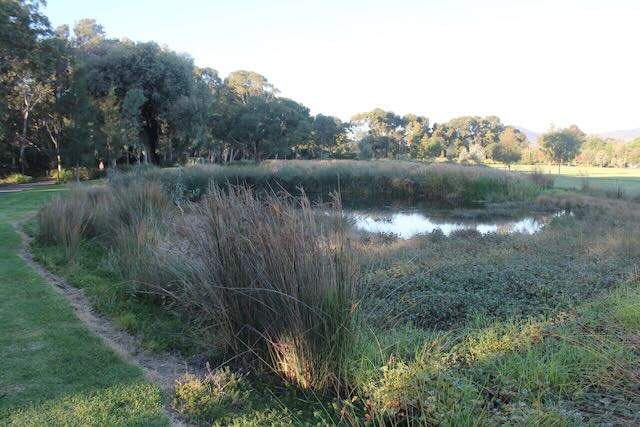Last updated on May 4th, 2025 at 06:24 am
The eastern suburbs of Adelaide are located along the foothill slopes of the Adelaide Hills. Before European colonisation, this area was covered in open forest and woodland. Settlement happened so rapidly that there wasn’t a consistent record of the type of native flora which pre-existed the cultivation of the foothill slopes. In 1996, Darrell Kraehenbuehl’s research was published:, Pre-European vegetation of Adelaide : a survey from the Gawler River to Hallett Cove. It identifies native vegetation patterns which existed prior to 1836, the date that colonists began to alter the landscape with settlements and agricultural practices.
This information was also made available in the form of a planting guide, Forests Woodlands of Adelaide Plains 1836, a Native Vegetation Planting Guide, which included a listing of the forest and woodland types and a detailed description of the understorey including small trees, shrubs both high and low, as well as grasses and groundcovers.
The survey data from Kraehenbuehl’s research uses information based on botanical records and samples from remaining vegetation defines areas of open forest and woodlands. The Planting Guide enumerates open forest and woodland stretching from the Gawler River in the north to Hallet Cove in the south.
The foothill slopes include the areas covering the city councils of Campbelltown, Norwood, Payneham, and St. Peter’s (NPSP), Burnside, as well as parts of Enfield/Port Adelaide, Tea Tree Gully, and Unley. The area roughly extends from Dry Creek linear park to Brownhill Creeks. The main woodlands occupying the foothills are listed below. The Planting Guide uses a colour key to link woodland type with the corresponding information about canopy, soil type, landscape and approximate boundaries as well as the corresponding eastern suburbs.
Southern Cypress Pine and Drooping Sheoak Woodland (N8)
- Canopy: Callitris preissii and Allocasuarina verticillata
- Soils: Grey sand over mottled sandy clay
- Landscape: Covers the footslopes at the eastern extent of Tea Tree Gully city council
- Eastern Suburbs: 10% of St. Agnes
Box Mallee, Drooping Sheoak, and Dryland Tea Tree (N12)
- Canopy: Eucalyptus porosa, Allocasuarina verticillata, Melaleuca lanceolata ssp. lanceolata
- Soils: Brown solonised soils
- Landscape: Foothills extending from Greenwith to Highbury in north within Tea Tree Gully council
- Eastern Suburbs: 20% of Dernancourt and 10% of Athelstone on either side of the Torrens river catchment; 40% of Highbury on the eastern side
SA Blue Gum Woodland (N3)
- Canopy: Eucalyptus leucoxylon
- Soils: Black earth, red brown soils, terra rosa
- Landscape: Foothills on both sides of the Torrens River. To the north, it extends as far as Surrey Downs within Tree Tree Gully council
- Eastern Suburbs: 80% of Newton, 20% of Rostrevor, 80% of Athelstone, Derancourt, 50% of Windsor Gardens, 50% of Klemzig, 50% of Vale Park
Box Mallee Woodland (N7)
- Canopy: Eucalyptus porosa
- Soils: Brown solonized, terra rossa, black earth, red brown clay and rendzina soils
- Landscape: Covers the Adelaide plains as far south as Ashford bordering on the City of Adelaide then extending north to Salisbury Heights on the edge of the Para River. It is also the dominant landscape for the Plains which include Elizabeth city council extending east to Gawler.
- Eastern Suburbs: 90% of Holden Hill, 50% of Gilles Plains, 50% of Windsor Gardens, 50% Klemzig, 40% of Dernancourt, Oakden, Hillcrest, NorthField, Greenacres, Hampstead Gardens, Manningham, North Adelaide
Red and SA Blue Gum Woodland (N4)
- Canopy: Eucalyptus camaldulensis and Eucalyptus leucoxylon
- Soils: Alluvial soils
- Landscape: This area covers the river course of the Torrens River on both banks. This woodland also extends to the river courses of the Gawler River, Para River, Brownhill Creek and the Sturt River in the far south.
- Eastern Suburbs: Campbelltown, 50% of Paradise, 10% of Athelsone, Felixstow, Marden, Royston Park, St. Peters, College Park, Hackney, Glynde, Payneham, Payneham South, Evandale, Marylands, Stepney, Kent Town, 20% of Newton, 85% of Hectorville, Tranmere, Firle, Trinity Gardens, Norwood, 80% Toorak Gardens, 80% of Rostrevor, Magill, Beulah Park, Kensington, Kensington Park, Kensington Gardens, Marryatville, Heathpool, 90% of Erindale, 20% of Wattle Park, 50% of Rose Park
Grey Box and River Red Gum Woodland (N5)
- Canopy: Eucalyptus microcarpa and Eucalyptus camaldulensis
- Soils: Red brown earths
- Landscape: This is the northern extension of the Black Forest which includes the city of Adelaide to the north of Brownhill Creek, most of Burnside council including Unley council as well as the northern area of Mitcham in the south east
- Eastern Suburbs: City of Adelaide, Rose Park, Dulwich, Tusmore, Goodwood, Unley, Parkside, Eastwood, Glenside, Frewville, Linden Park, Hazelwood Park, Burnside, Glenunga, St. George’s, Beaumont, Hyde Park, Malvern, Highgate, Myrtle Bank, 10% of Glen Osmond, Kingswood, Urbrae, Netherby, Springfield
Using the listing of suburbs, you will be able to find the native vegetation as listed in the Planting Guide, corresponding to the woodland canopy. The colour key will then identify the understorey associated with the woodland type.
